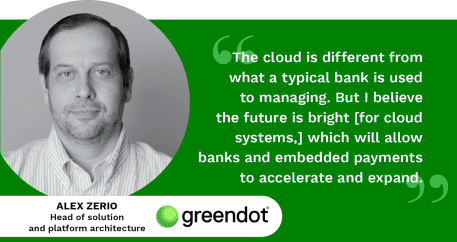Learn From an Insider the Benefits of Core Modernization and Embedded Finance

Not a news flash: Outdated core systems keep banks from enabling the embedded finance products that their customers want, something that Alex Zerio, head of solution and platform architecture at Green Dot Corporation, says can be addressed by moving to the cloud.
An interview with Alex Zerio, head of solution and platform architecture at Green Dot Corporation, on how embedded finance and cloud technology can improve banking.
—
Consumers have increasingly demanded digital services in recent years, especially due to pandemic-related restrictions.
Seamlessness and ease of use are the names of the game, with customers expecting payments to be just as easy to navigate as eCommerce, social media or any other online interaction in their lives.

“The trend is really about how seamless or simple it is to do banking or to do payments,” Zerio said. “I think more and more, we are less willing to spend time saying, ‘Which card should I take? Where’s my wallet?’ That notion of seamlessness when it comes to digital adoption is the key trend from a user perspective.”
Embedded finance is vital for enabling these seamless and simple banking services.
Customers who shop online, for instance, want the built-in ability to pay for items without leaving an app or webpage, with their bank of choice offering a one-click payment option. Banks would be well-served to allow their customers’ favorite brands to be front and center when it comes to digital payments, Zerio explained.
“It’s really our partners, the brands, that ultimately have that relationship with the customers, so it’s important to allow them to facilitate the lives of their users by embedding payment capabilities within their own services,” he said. Embedded finance is the next step, “where you’re not even thinking about the bank as somebody you’re having a relationship with. Instead, you’re perceiving Amazon or Walmart, and the payment capabilities come as part of the service these entities are providing to you.”
This capability is currently out of reach for many banks due to outdated core systems, but cloud technology could help level the playing field.
Upgrading legacy systems can be an expensive, time-consuming process that requires immense IT expertise, but shifting these core capabilities to the cloud outsources the need for these resources. This, in turn, can unlock advanced capabilities such as embedded finance.
“Cloud adoption plays a big role in driving efficiency gains and cost savings, and the outcome of it is that managing the complexity of core systems becomes simpler and easier,” he said. “This allows mind space, energy and investments to be routed toward the innovation aspects of technology that we can deploy.”
